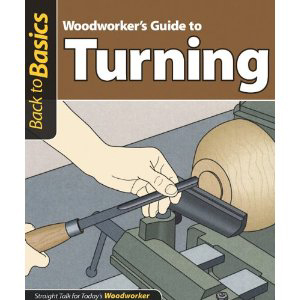
Woodworker's Guide To Turning, by John Kelsey - Book Review
by J. Norman Reid
Delaplane, VA
This small volume, 140 pages, is packed full of everything a beginning woodturner needs to get started and progress to the intermediate skill level and beyond. Included is basic information on everything from tools to techniques. As is typical of many Fox Chapel books, this one is succinct, comprehensive and goes straight to the point on each of the many topics it covers. The book is thoroughly illustrated with clear drawings and photos that leave nothing to the imagination, a valuable quality in an instructional guide such as this.
The book is divided into 5 main sections.
-
The Setting Up section describes the parts of a lathe, tool rests and lathe stands, lathe tools, chucks and other accessories, measuring and marking tools, safety equipment, setting the turning speed, and selecting wood for turning. Bonuses are plans for building your own lathe stand and a rack for storing turning tools.
-
The Sharpening section covers sharpening equipment, offers a very helpful guide to grinding stones on page 38, and describes the procedures for sharpening roughing gouges, spindle gouges, skew chisels, parting tools and scrapers. Included here is a plan for building your own gouge sharpening jig.
-
The Spindle Turning section opens the portion of the book that focuses on turning techniques. Page 51 provides helpful illustrations of the cuts typically made in turning spindles such as table legs. Following this are discussions of setting up, mounting the blank, how to rub the bevel on the stock, cutting with the grain, making basic spindle cuts, gauging cut depth, making sizing cuts, grooving cuts, coved and square shoulder cuts, pommels, parting off, turning tenons, supporting thin spindles, and decorative spindle cuts (including coves, beads, balls and fillets, and duplicating). More advanced topics include making split and carved turnings, reeding, and fluting and finishing. Also included are a discussion of making your own tool handles, plans for making a fluting jig, and a useful comparison of finishing options.
-
The Faceplate Turning section for bowls and plates begins by reviewing alternative ways to attach blanks for the lathe. Plans for making a centering jig and a contraction chuck are included here. Also reviewed are scroll chucks, screw chucks, Jacobs chucks, pin chucks, collet chucks, collar chucks and glue blocks. Then comes a consideration of body and tool position, correct and incorrect cutting techniques, rounding and shaping the outside of the bowl, flattening its bottom, preparing the base for a chuck, finishing the outside by smoothing and sanding, hollowing out the bowl, checking wall thickness, smoothing the interior, sanding the inside, and finishing and polishing. This section concludes with a separate treatment of natural edge bowls: planning them, preparing the blank, truing and shaping the outside, hollowing, flattening the base, and smoothing and sanding the outside. This section presents a plan for making your own depth gauge as well.
-
The final section, Turning Projects, introduces more advanced techniques and project ideas to stimulate growth into new areas once spindles and bowls have been mastered. These include off-axis (off-center) turning, cabriole legs, goblets, lidded boxes, a dried flower vase, tabletops, and laminated bowls and plates.
In summary, this brief guide provides a thorough review of all a prospective turner needs to know to get started and progress to at least an intermediate level. While other more in-depth guides are available to explore advanced or specialized techniques and projects, this book has a comprehensiveness and clarity that provides an excellent start and may even be the only guide the occasional woodturner will ever need. Experienced turners may find this to be a helpful review of techniques and a useful reference on materials and types of cuts, but they are likely to find more advanced guides that are better suited to stretching their abilities.
My complaints about the book are few. It would have been helpful to many turners, I suspect, had it been spiral bound so it would lie flat on the workbench during use. In addition, the book omits consideration of the more recent carbide turning tools, focusing instead on traditional cutting and scraping tools. Given that carbide tools are essentially scrapers, this omission may have little real importance, but for beginners coverage of these easy-to-use tools would have been helpful.
That said, I liked the book, especially for its to-the-point style. I will come back to it again and again for answers to my questions about sharpening and turning techniques as I build my own skills.
If you are just starting out in the wonderful world of woodturning and don't know where or how to begin, you can't go wrong by starting with this guide. If you've already begun to turn, you may also find this a good reference for answers to many of your questions.
CLICK HERE to purchase your own copy
of
Woodworker's Guide To Turning
This article first appeared in the December 2013 issue of our sister publication,
Wood News Online
.
The author is a woodworker, writer and photographer living in Delaplane, Virginia, in the
foothills of the Blue Ridge Mountains with his wife, four cats and a woodshop full of
power and hand tools.
He can be reached by email at
nreid@fcc.net
.
Return to
The Highland Woodturner
front page
Return to
Wood News
front page


|
|
